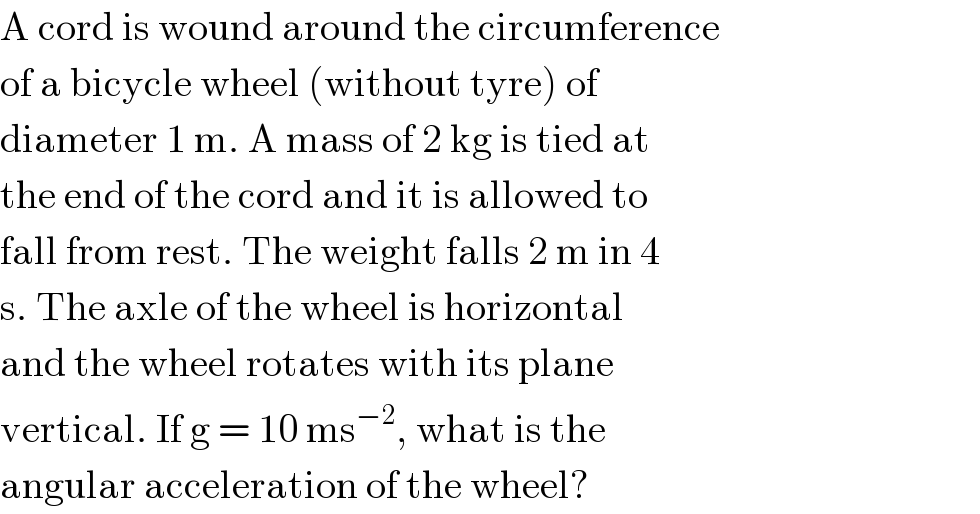
Question Number 23932 by Tinkutara last updated on 10/Nov/17

$$\mathrm{A}\:\mathrm{cord}\:\mathrm{is}\:\mathrm{wound}\:\mathrm{around}\:\mathrm{the}\:\mathrm{circumference} \\ $$$$\mathrm{of}\:\mathrm{a}\:\mathrm{bicycle}\:\mathrm{wheel}\:\left(\mathrm{without}\:\mathrm{tyre}\right)\:\mathrm{of} \\ $$$$\mathrm{diameter}\:\mathrm{1}\:\mathrm{m}.\:\mathrm{A}\:\mathrm{mass}\:\mathrm{of}\:\mathrm{2}\:\mathrm{kg}\:\mathrm{is}\:\mathrm{tied}\:\mathrm{at} \\ $$$$\mathrm{the}\:\mathrm{end}\:\mathrm{of}\:\mathrm{the}\:\mathrm{cord}\:\mathrm{and}\:\mathrm{it}\:\mathrm{is}\:\mathrm{allowed}\:\mathrm{to} \\ $$$$\mathrm{fall}\:\mathrm{from}\:\mathrm{rest}.\:\mathrm{The}\:\mathrm{weight}\:\mathrm{falls}\:\mathrm{2}\:\mathrm{m}\:\mathrm{in}\:\mathrm{4} \\ $$$$\mathrm{s}.\:\mathrm{The}\:\mathrm{axle}\:\mathrm{of}\:\mathrm{the}\:\mathrm{wheel}\:\mathrm{is}\:\mathrm{horizontal} \\ $$$$\mathrm{and}\:\mathrm{the}\:\mathrm{wheel}\:\mathrm{rotates}\:\mathrm{with}\:\mathrm{its}\:\mathrm{plane} \\ $$$$\mathrm{vertical}.\:\mathrm{If}\:\mathrm{g}\:=\:\mathrm{10}\:\mathrm{ms}^{−\mathrm{2}} ,\:\mathrm{what}\:\mathrm{is}\:\mathrm{the} \\ $$$$\mathrm{angular}\:\mathrm{acceleration}\:\mathrm{of}\:\mathrm{the}\:\mathrm{wheel}? \\ $$
Answered by ajfour last updated on 10/Nov/17

$${s}=\frac{\mathrm{1}}{\mathrm{2}}\left(\alpha{R}\right){t}^{\mathrm{2}} \\ $$$$\Rightarrow\:\alpha\:=\frac{\mathrm{2}{s}}{{t}^{\mathrm{2}} {R}}\:=\frac{\mathrm{2}×\mathrm{2}}{\mathrm{16}×\left(\mathrm{1}/\mathrm{2}\right)}\:=\mathrm{0}.\mathrm{5}\:{rad}/{s}^{\mathrm{2}} \:. \\ $$
Commented by Tinkutara last updated on 10/Nov/17

$$\mathrm{Why}\:\mathrm{acceleration}\:\mathrm{of}\:\mathrm{mass}\:\mathrm{is}\:\mathrm{linear} \\ $$$$\mathrm{acceleration}\:\mathrm{of}\:\mathrm{wheel}? \\ $$
Commented by ajfour last updated on 10/Nov/17

$${because}\:{as}\:{much}\:{the}\:{cord}\:{unwinds} \\ $$$${so}\:{much}\:{the}\:{mass}\:{comes}\:{down}. \\ $$$$\:\:{Rd}\theta\:=\:{dy} \\ $$$$\Rightarrow\:{R}\left(\frac{{d}\theta}{{dt}}\right)\:=\:\frac{{dy}}{{dt}} \\ $$$$\Rightarrow\:\:{R}\left(\frac{{d}^{\mathrm{2}} \theta}{{dt}^{\mathrm{2}} }\right)\:=\:\frac{{d}^{\mathrm{2}} {y}}{{dt}^{\mathrm{2}} } \\ $$$$\:{a}_{{wheel}} =\alpha{R}\:=\:{a}_{{mass}} \:. \\ $$
Commented by Tinkutara last updated on 10/Nov/17

$$\mathrm{Thank}\:\mathrm{you}\:\mathrm{very}\:\mathrm{much}\:\mathrm{Sir}! \\ $$
